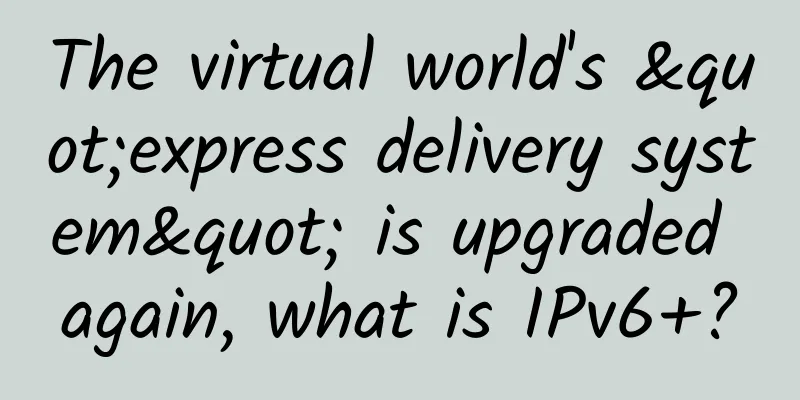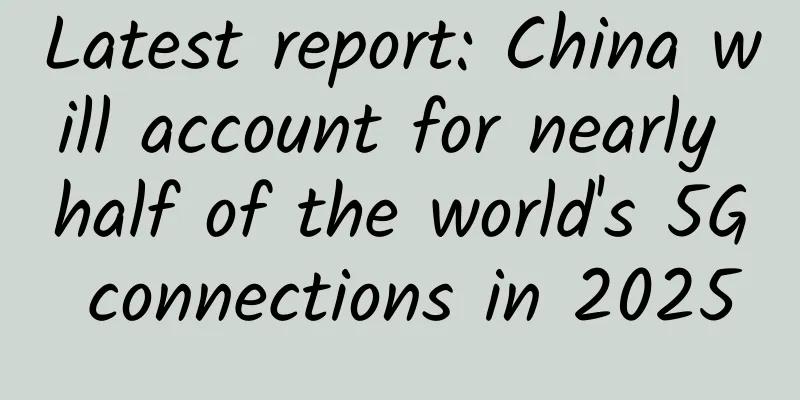The virtual world's "express delivery system" is upgraded again, what is IPv6+?

|
This article is reproduced from Leiphone.com. If you need to reprint it, please go to Leiphone.com official website to apply for authorization. During MWC22 Barcelona Mobile World Congress, Zhao Zhipeng, Vice President of Huawei's Data Communication Product Line, mentioned in his keynote speech at the IPv6 Forum that from the Internet of Everyone to the Internet of Everything, IPv6+ has been commercially used in more than 100 countries around the world, effectively supporting the digital development of various industries such as finance, manufacturing, energy, education, and medical care. As we get closer to the era of the Internet of Everything, people can't help but become curious about IPv6+, the "behind-the-scenes driving force": What exactly is IPv6+? With the continuous development of science and technology, the world has become divided with the Internet as the dividing line: people call the offline world the physical world, and the online world the virtual world. In the physical world, everyone has their own identification, such as an ID card. The virtual world, like the physical world, needs an identity system. The IP address is the ID card in the virtual world, and the Internet is a "express delivery system". The IP protocol is the "workflow and system" of the express delivery system. All the information we need to transmit, including text, pictures, audio, video, etc., needs to be packaged into "express parcels" and then transported by the express delivery system to the final destination. After the birth of the Internet, the v4 version of the IP protocol was used for a long time, which is the well-known IPv4. We can think of it as the first generation of express delivery system. Later, with the rapid development of the Internet, the original IPv4 exposed many problems, and the "express delivery system" was upgraded to the second generation, introducing MPLS (Multi-Protocol Label Switching) technology. Today, the challenges facing the Internet have far exceeded the capabilities of the second-generation "express delivery system". The third-generation "express delivery system" based on IPv6 and IPv6+ has made its debut. IPv6 is the sixth version of the Internet Protocol and is the next generation IP protocol designed by the Internet Engineering Task Force (IETF) to replace IPv4. Due to the shortage of IPv4 addresses, the application and development of the Internet has been seriously restricted. The use of IPv6 solves the problem of the number of network address resources and can assign an IP address to every grain of sand on the earth. IPv6+ is an enhanced innovation of IPv6, and a comprehensive upgrade of network capabilities based on IPv6. In the IPv6 white paper released by ETSI in August 2020, ETSI believes that IPv6+ includes protocol innovations based on IPv6 and combines IPv6 with AI. Represented by protocol innovations such as SRv6, it combines network intelligent innovation technologies such as network analysis and intelligent tuning to achieve intelligent path planning. Rapid service deployment, automated operation and maintenance, quality visualization, SLA guarantee, application awareness, etc. At the same time, in the Gap Analysis report released by ETSI in August 2021, ETSI concluded that IPv6+ comprehensively improves IP network capabilities in six dimensions: ultra-broadband, wide connectivity, determinism, low latency, automation and security. The introduction of IPv6 and IPv6+ is creating a third-generation "express delivery system" for us in the future. Based on the IPv6-based "express delivery system", each user has his or her own identity, and the courier can deliver the package directly to the user. This eliminates the need for a second delivery by a security guard or express locker, reduces the risk of package loss, and simplifies the process. The second major improvement of IPv6 is the upgrade of "express packaging". The IPv6 message header is longer and can record more content and information. In other words, we can put more labels on the "express packaging" to identify the attributes of the goods in the carton, such as: heavy goods, fragile goods, urgent goods, etc. The "express delivery system" can quickly determine the services required for the express package, such as whether it needs to be expedited or handled with care. In this way, the "express delivery company" can provide more refined services to different customers based on the information displayed on the package, and adopt differentiated charging standards. The "express delivery company" can also take the high-quality route and provide exclusive express delivery channels to enable high-end users to enjoy exclusive resources. Similarly, because IPv6+ has made comprehensive capacity improvements on IPv6, it can accurately identify the attributes of IPv6 data packets and provide corresponding services, thereby helping operators better understand the data situation in the entire network and better mobilize and allocate resources. First, IPv6+ upgrades navigation capabilitiesThe transportation route of the traditional "express delivery system" is relatively fixed and rigid. From the starting point to the end point, the transport vehicle passes through each intersection, and the intersection specifies the next direction to go. IPv6 can optimize the route by combining with SR (Segment Routing) technology and SDN (Software Defined Network) technology. In other words, when the express package departs, it has already obtained the best route from the starting point to the end point from the management center. Each route selection is carried out according to the plan, which can avoid congestion and detours. The super strong path arrangement capability can greatly improve efficiency. Second, IPv6+ can provide a dedicated channel for servicesIPv6, combined with network slicing technology, can open up a dedicated channel on the road for key businesses. For example, there is a high demand for large-granularity video transmission from A to B. In this case, a dedicated line for large-granularity video services can be established to better meet transmission needs. It's like if there is a great demand for transporting seafood from point A to point B, the express company will purchase more cold chain transport vehicles and invest them exclusively in this route to earn more profits. Third, IPv6+ upgrades network operation and maintenance capabilitiesThe first is centralized management. IPv6+ can easily convert configuration intentions into scripts and automatically deploy them to various network nodes. After the introduction of AI, it can automatically analyze fault phenomena and find causes more quickly. It can also proactively identify potential fault risks in the network in advance based on the learning of fault models to prevent accidents. Centralized management + AI management greatly reduces the difficulty of network maintenance, improves operation and maintenance efficiency, and reduces maintenance costs. Fourth, the security defense capability of IPv6+ has been greatly improved compared with IPv4, truly realizing the integrated defense of cloud, network and security.In traditional networks, due to the scarcity of IPv4 addresses, there are a large number of private networks, making it difficult to trace malicious behavior. For example, a bad guy hides in the dark and sends out a problematic package, causing damage to the express delivery system, but it is impossible to find out who did it. Networks that support IPv6+ can use public network addresses instead of private network addresses, which means that every package transported in the "express delivery system" has real and traceable sender information. Without the disguise of the private network, sabotage will be exposed. The upgraded express delivery packaging (data message structure) also greatly increases the difficulty for saboteurs to maliciously forge and eavesdrop on packages, enhancing the security and privacy of packages. In short, IPv6+ will support the high-speed, efficient, flexible and intelligent upgrade of the next generation Internet. It can provide differentiated service capabilities to meet the application needs of thousands of industries, adapt to the business carrying needs of different industries, support the digital transformation of various industries, help the upgrade of consumer Internet to industrial Internet, and promote the development of the entire digital economy. |
<<: What happens when we enter a URL into our browser?
>>: 3G, 4G, 5G, why do we need so many "Gs"?
Recommend
AnalyticDB PostgreSQL teaches you how to implement distributed consistent backup and recovery
1. Background AnalyticDB for PostgreSQL (ADB PG f...
TripodCloud: US CN2 GIA line VPS with large hard disk $40.99/half year onwards
TripodCloud (Yunding Network) is a relatively low...
Check out the five important characteristics of SD-WAN in 2019
SD-WAN has reached a new inflection point in 2019...
RAKsmart Bare Metal Cloud/Cloud Server/VPS 30% off, Dedicated Server Limited Flash Sale Starting from $30/month
Coinciding with the Chinese New Year, RAKsmart ha...
Market forecast: China's smart home market will reach US$48.2 billion in 2027
[[422668]] According to market research firm Rese...
V5.NET: 32 yuan/month-dual core/2GB/40GB/500GB@500Mbps/Hong Kong data center
V5 Server (V5.NET) has launched new cloud servers...
[Closed] NextArray: $1.09/month KVM-1GB/10GB/1TB/Dallas Data Center
[Closed] NextArray is a foreign hosting company fo...
Smart home, a bone that will eventually be chewed by NB-IoT?
As for the huge scale of the smart home market, w...
The Ministry of Industry and Information Technology launched a special rectification campaign for the Internet industry: focusing on rectifying issues such as App launching pop-up windows to deceive and mislead users
According to the website of the Ministry of Indus...
Talk about how 5G and AI work together from the perspective of 5 major industry applications
As new technologies continue to emerge, more and ...
Shumai Technology offers a limited-time 45% discount, with monthly payment starting from 300 yuan for Hong Kong independent servers
Shumai Technology is a business that mainly provi...
What exactly is RedCap?
[[431894]] With the continuous advancement of 3GP...
Several major trends in the future of LPWAN: large connections, complementary technologies, and everyone being an operator
Although LPWAN has a history of several decades, ...
Sharktech 20th Anniversary Cloud Server 20% off, Netherlands/Denver/Los Angeles High Defense Private Cloud/Public Cloud Server
Sharktech is currently carrying out a 20th annive...
5G ToB development enters a golden period, and industry-specific networks enable digital transformation
[[386226]] 1. Introduction With the vigorous prom...









![[Sharing] Project Practice of Network Automation: Scenarios, Tools and Solutions](/upload/images/67eba49a0bb8a.webp)